Improving Coal Flotation by Gaseous Collector Pretreatment Method and its Potential Application in Preparing Coal Water Slurry
Abstract
:1. Introduction
2. Materials and Methods
2.1. Materials
2.2. FTIR Measurement and Pore Distribution Analysis
2.3. Contact Angle Measurements
2.4. Gaseous Pretreatment Method
2.5. Flotation Tests
3. Results and Discussion
3.1. FTIR Results and Pore Structure Characteristics
3.2. Contact Angle Results
3.3. Dodecane Adsorption Results
3.4. Flotation Results
3.5. Probable Enhancing Mechanism
3.6. Preparation of Coal Water Slurry (CWS)
4. Conclusions
- (1)
- Low-rank coal was very hydrophilic due to the high concentration of -OH group and the large number of pores and cracks of the coal.
- (2)
- The contact angles of water on the surface of the coal obtained by gaseous pretreatment method were higher than that obtained by conventional pretreatment method. And the water droplets spread much slower on the gaseous pretreated coal surface.
- (3)
- Low-rank coal had a very strong adsorption capacity for gaseous dodecane. The dodecane molecule can directly enter into the pores on the coal surface, improving the hydrophobicity of the LRC.
- (4)
- Clean coal with 67.2% CMR and 10.5% ash content was obtained using gaseous dodecane pretreatment flotation method. Coal water slurry with 60% concentration was made using the flotation clean coal.
Author Contributions
Funding
Acknowledgments
Conflicts of Interest
References
- Xia, W.; Niu, C.; Ren, C. Enhancement in floatability of sub-bituminous coal by low-temperature pyrolysis and its potential application in coal cleaning. J. Clean. Prod. 2017, 168, 1032–1038. [Google Scholar] [CrossRef]
- Gui, X.; Liu, J.; Cao, Y.; Miao, Z.; Li, S.; Xing, Y.; Wang, D. Coal Preparation Technology: Status and Development in China. Energy Environ. 2015, 26, 997–1013. [Google Scholar] [CrossRef]
- Nyashina, G.S.; Kuznetsov, G.V.; Strizhak, P.A. Energy efficiency and environmental aspects of the combustion of coal-water slurries with and without petrochemicals. J. Clean. Prod. 2018, 172, 1730–1738. [Google Scholar] [CrossRef]
- Wang, R.; Ma, Q.; Ye, X.; Li, C.; Zhao, Z. Preparing coal slurry from coking wastewater to achieve resource utilization: Slurrying mechanism of coking wastewater–coal slurry. Sci. Total Environ. 2019, 650, 1678–1687. [Google Scholar] [CrossRef] [PubMed]
- Chen, X.; Wang, C.; Wang, Z.; Zhao, H.; Liu, H. Preparation of high concentration coal water slurry of lignite based on surface modification using the second fluid and the second particle. Fuel 2019, 242, 788–793. [Google Scholar] [CrossRef]
- Vershinina, K.; Shabardin, D.; Strizhak, P. Burnout rates of fuel slurries containing petrochemicals, coals and coal processing waste. Powder Technol. 2019, 343, 204–214. [Google Scholar] [CrossRef]
- Shen, L.; Liu, L.; Zhu, J.; Qiao, E. Effect of Oleic Acid on Froth Properties and Reverse Flotation Performance of Thermal Coal. Trans. Indian Inst. Met. 2018, 71, 1841–1846. [Google Scholar] [CrossRef]
- Chang, Z.; Chen, X.; Peng, Y. The interaction between diesel and surfactant Triton X-100 and their adsorption on coal surfaces with different degrees of oxidation. Powder Technol. 2019, 342, 840–847. [Google Scholar] [CrossRef]
- Xia, Y.; Wang, L.; Zhang, R.; Yang, Z.; Xing, Y.; Gui, X.; Cao, Y.; Sun, W. Enhancement of flotation response of fine low-rank coal using positively charged microbubbles. Fuel 2019, 245, 505–513. [Google Scholar] [CrossRef]
- Zhen, K.; Zhang, H.; Li, C.; Li, X. Effect of oxidized diesel oil on the flotation response of the low-rank coal by plasma oxidation method. Fuel 2019, 245, 13–20. [Google Scholar] [CrossRef]
- Yang, L.; Zhu, Z.; Qi, X.; Yan, X.; Zhang, H. The Process of the Intensification of Coal Fly Ash Flotation Using a Stirred Tank. Minerals 2018, 8, 597. [Google Scholar] [CrossRef]
- Xu, M.; Xing, Y.; Cao, Y.; Gui, X. Effect of Dodecane and Oleic Acid on the Attachment between Oxidized Coal and Bubbles. Minerals 2018, 8, 29. [Google Scholar] [CrossRef]
- Xu, M.; Xing, Y.; Cao, Y.; Gui, X. Waste colza oil used as renewable collector for low rank coal flotation. Powder Technol. 2019, 344, 611–616. [Google Scholar] [CrossRef]
- Cai, Y.; Du, M.; Wang, S.; Liu, L. Flotation characteristics of oxidized coal slimes within low-rank metamorphic. Powder Technol. 2018, 340, 34–38. [Google Scholar] [CrossRef]
- Xia, W.; Yang, J. Changes in surface properties of anthracite coal before and after inside/outside weathering processes. Appl. Surf. Sci. 2014, 313, 320–324. [Google Scholar] [CrossRef]
- Zhang, H.; Liu, W.; Xu, H.; Zhuo, Q.; Sun, X. Adsorption Behavior of Methyl Laurate and Dodecane on the Sub-Bituminous Coal Surface: Molecular Dynamics Simulation and Experimental Study. Minerals 2019, 9, 30. [Google Scholar] [CrossRef]
- Xia, W.; Li, Y.; Nguyen, A.V. Improving coal flotation using the mixture of candle soot and hydrocarbon oil as a novel flotation collector. J. Clean. Prod. 2018, 195, 1183–1189. [Google Scholar] [CrossRef]
- Atesok, G. A new flotation scheme for a difficult-to-float coal using pitch additive in dry grinding. Fuel 2002, 79, 1509–1513. [Google Scholar] [CrossRef]
- Ahmed, H.A.M.; Drzymala, J. Upgrading difficult-to-float coal using microemulsion. Min. Metall. Explor. 2018, 29, 88–96. [Google Scholar] [CrossRef]
- Petukhov, V.N.; Girevaya, K.Y.; Kubak, D.A.; Girevoy, T.A. Interaction of the coal surface with water. Coke Chem. 2013, 56, 292–298. [Google Scholar] [CrossRef]
- Xia, W.; Wang, Y. Role of prewetting/immersion time in the attachment time between air bubble and Taixi oxidized coal. Int. J. Miner. Process. 2017, 163, 9–13. [Google Scholar] [CrossRef]
- Xia, W.; Yang, J. Effect of pre-wetting time on oxidized coal flotation. Powder Technol. 2013, 250, 63–66. [Google Scholar] [CrossRef]
- Xia, W.; Yang, J.; Zhu, B. Flotation of oxidized coal dry-ground with collector. Powder Technol. 2012, 228, 324–326. [Google Scholar] [CrossRef]
- Xia, W.; Zhou, C.; Peng, Y. Enhancing flotation cleaning of intruded coal dry-ground with heavy oil. J. Clean. Prod. 2017, 161, 591–597. [Google Scholar] [CrossRef]
- Yang, Z.; Xia, Y.; Li, M.; Ma, Z.; Xing, Y.; Gui, X. Effects of pore compression pretreatment on the flotation of low-rank coal. Fuel 2019, 239, 63–69. [Google Scholar] [CrossRef]
- Xia, W.; Yang, J.; Liang, C. Effect of microwave pretreatment on oxidized coal flotation. Powder Technol. 2013, 233, 186–189. [Google Scholar] [CrossRef]
- Peng, Y.; Mao, Y.; Xia, W.; Li, Y. Ultrasonic flotation cleaning of high-ash lignite and its mechanism. Fuel 2018, 220, 558–566. [Google Scholar] [CrossRef]
- Zhen, K.; Zheng, C.; Li, C.; Zhang, H. Wettability and flotation modification of long flame coal with low-temperature pyrolysis. Fuel 2018, 227, 135–140. [Google Scholar] [CrossRef]
- Shen, L.; Min, F.; Liu, L.; Zhu, J.; Xue, C.; Cai, C.; Zhou, W.; Wang, C. Application of gaseous pyrolysis products of the waste cooking oil as coal flotation collector. Fuel 2019, 239, 446–451. [Google Scholar] [CrossRef]
- Chen, Y.; Xu, G.; Huang, J.; Eksteen, J.; Liu, X.; Zhao, Z. Characterization of coal particles wettability in surfactant solution by using four laboratory static tests. Colloids Surfaces A Physicochem. Eng. Asp. 2019, 567, 304–312. [Google Scholar] [CrossRef]
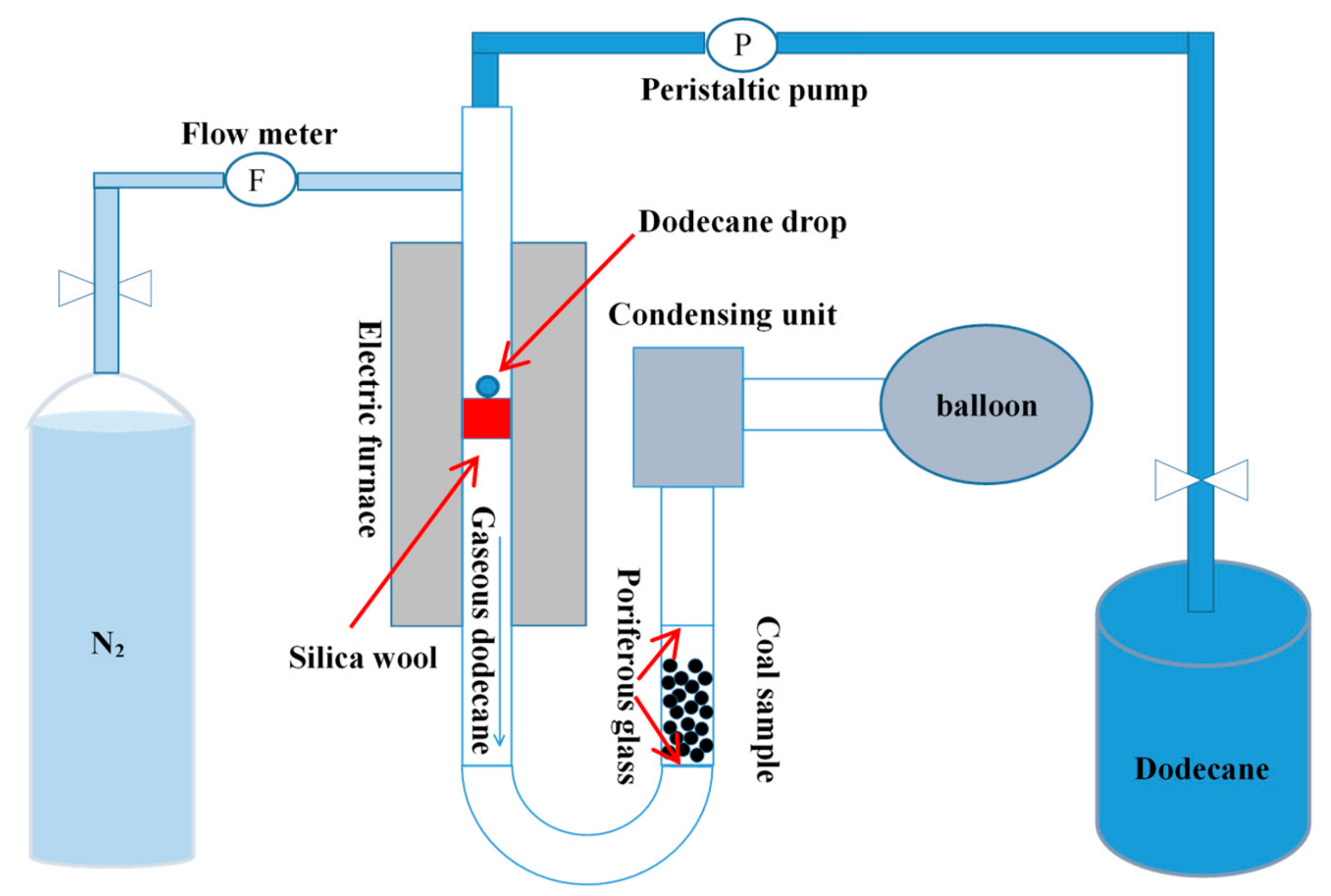
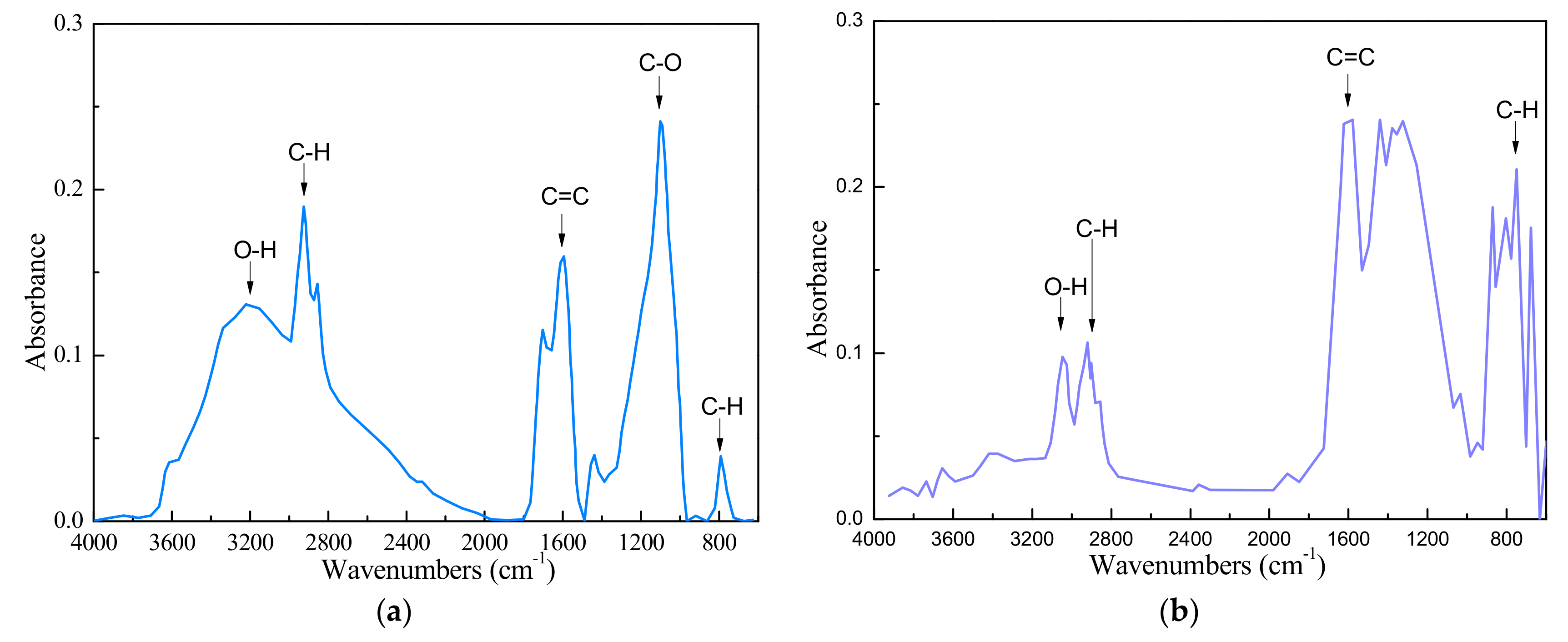
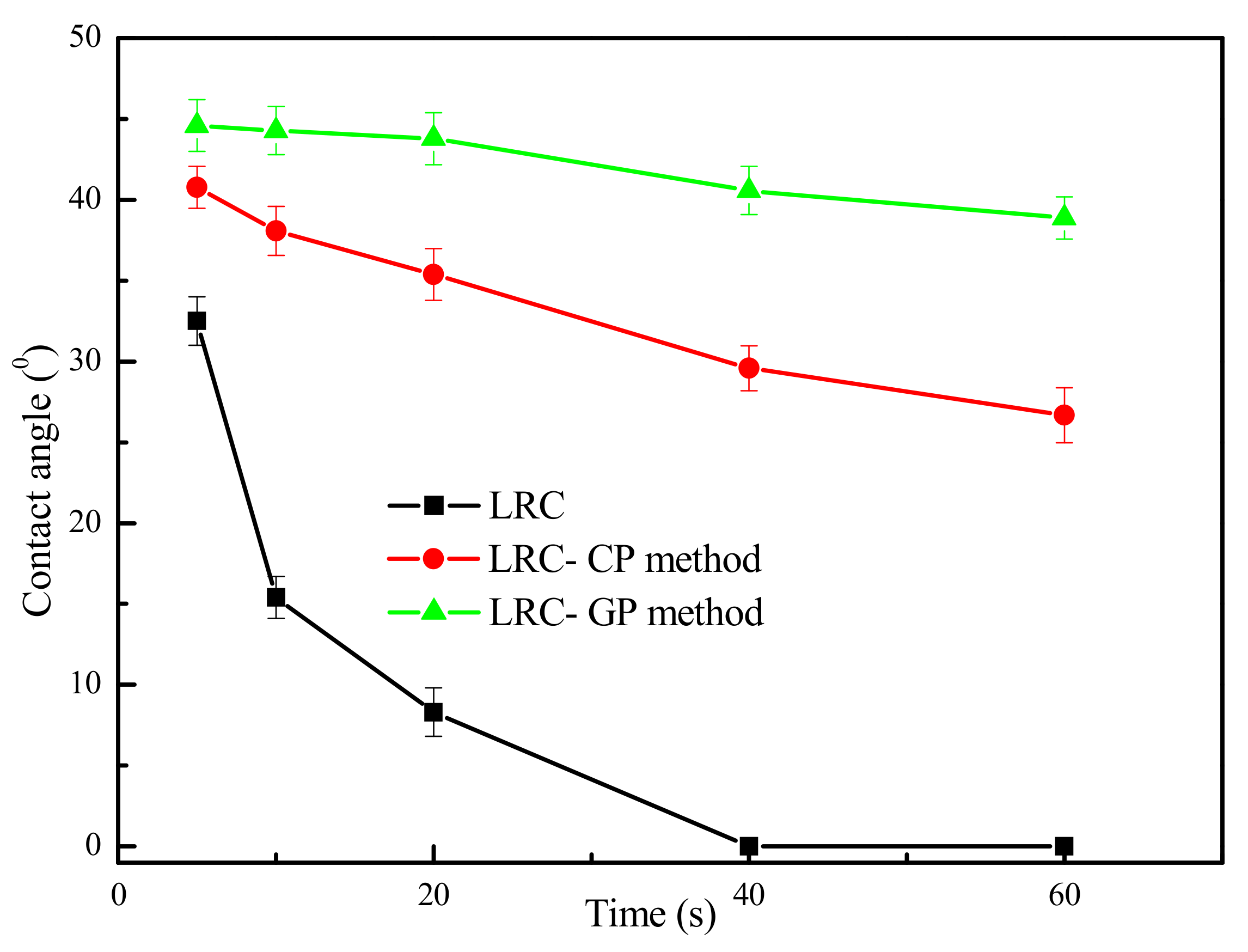
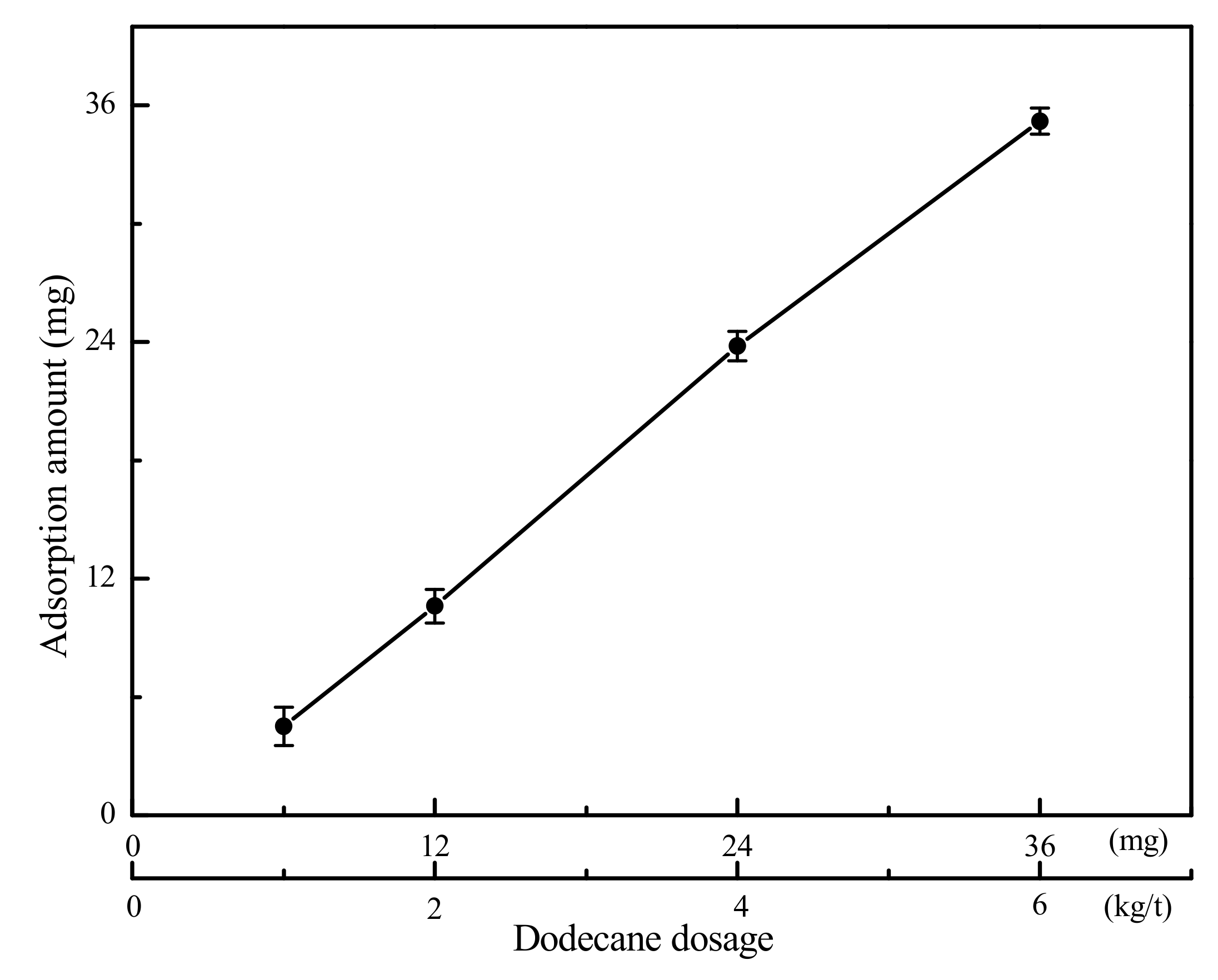

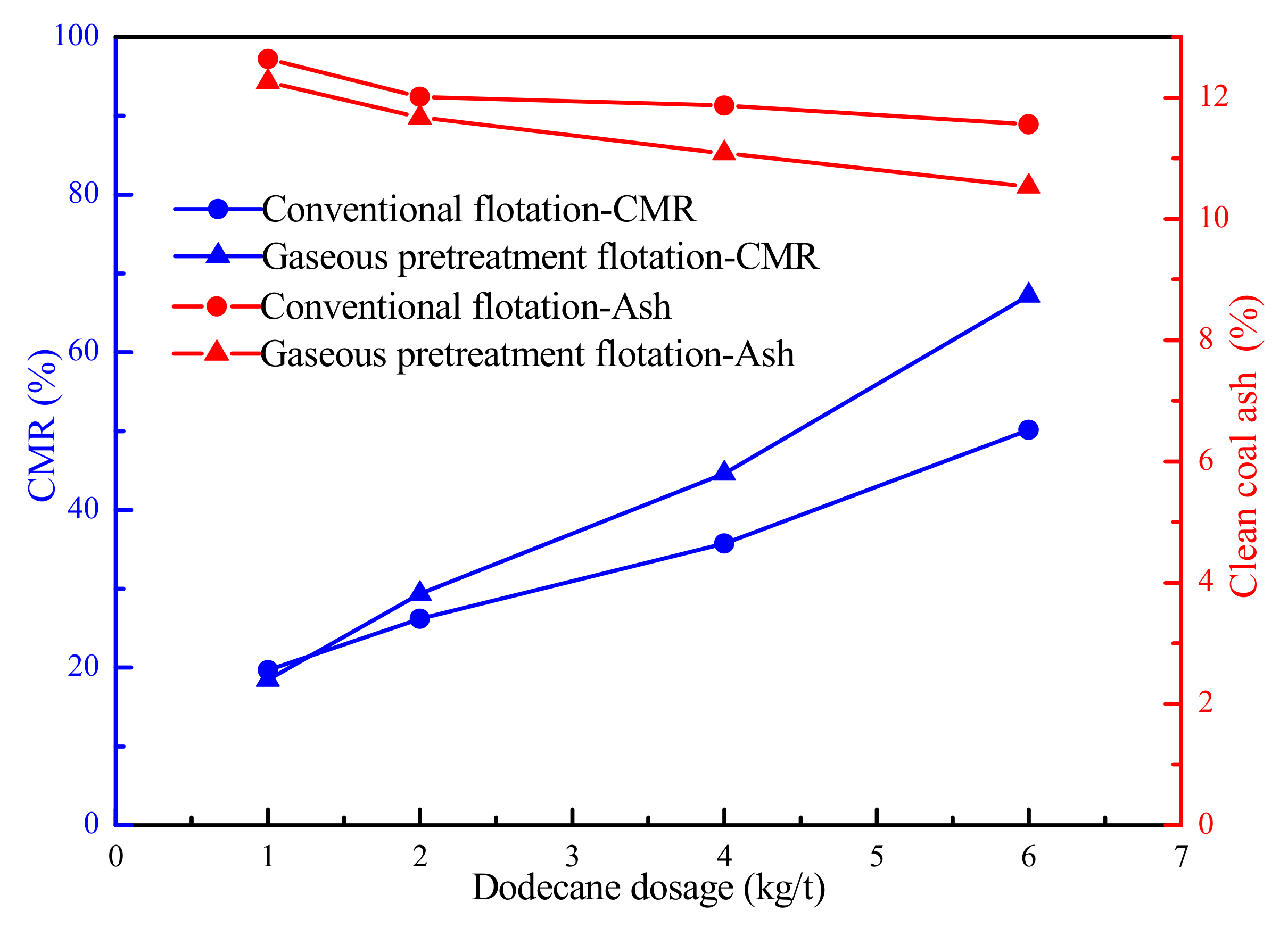
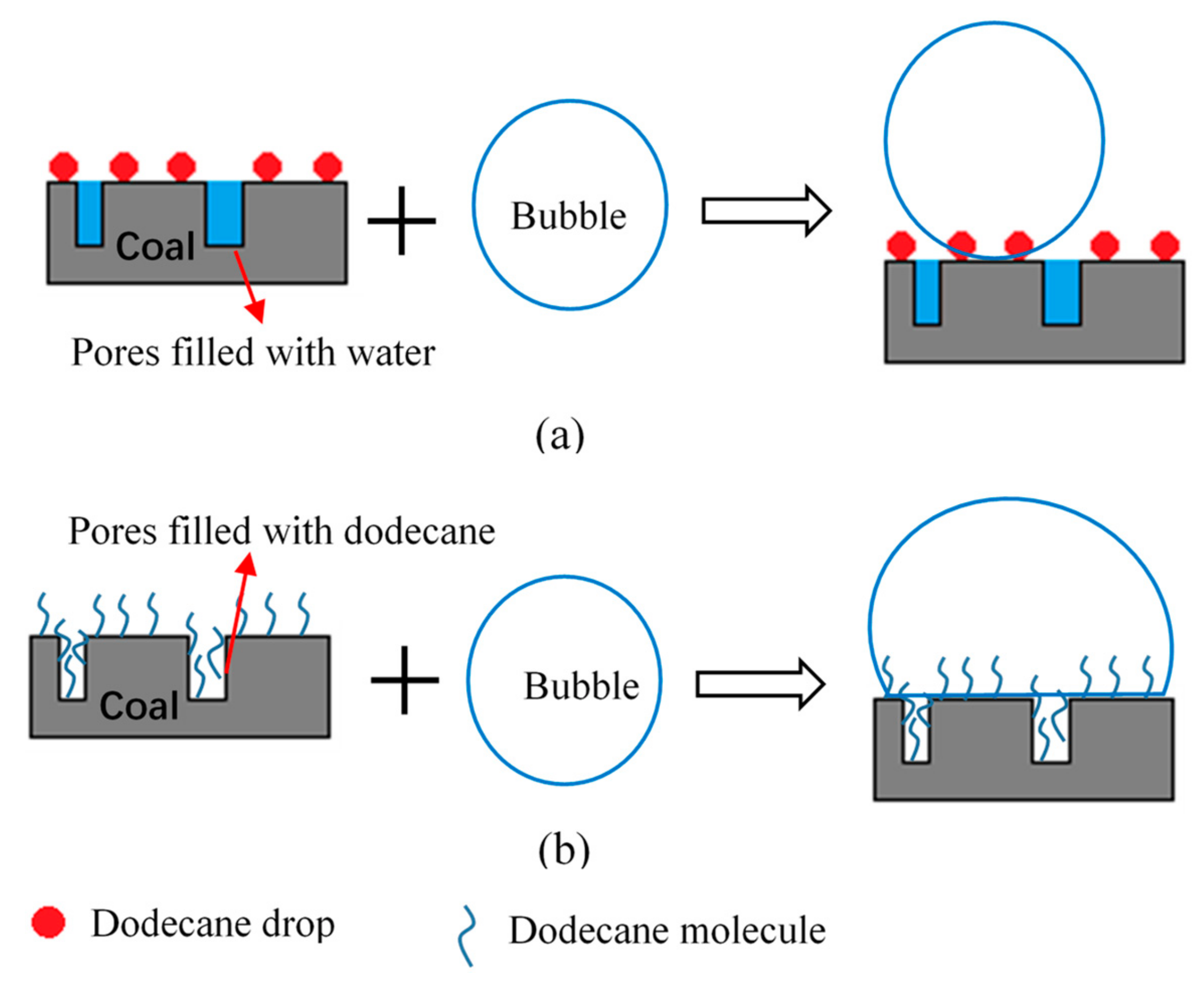

| Mad (%) | Aad (%) | Vad (%) | FCad (%) |
|---|---|---|---|
| 6.57 | 31.84 | 24.86 | 36.73 |
| Size Fraction (mm) | Percentage (%) | Ash Content (%) |
|---|---|---|
| 0.50–0.25 | 8.67 | 15.65 |
| 0.25–0.125 | 7.69 | 20.26 |
| 0.125–0.075 | 10.21 | 23.13 |
| 0.075–0.045 | 26.42 | 25.58 |
| −0.045 | 47.01 | 42.13 |
| Total | 100.00 | 31.84 |
| Density Fraction (g/cm3) | Yield (%) | Ash Content (%) |
|---|---|---|
| −1.3 | 2.26 | 4.24 |
| 1.3–1.4 | 20.20 | 6.08 |
| 1.4–1.5 | 22.31 | 10.12 |
| 1.5–1.6 | 10.12 | 18.65 |
| +1.6 | 45.11 | 58.46 |
| Total | 100.00 | 31.84 |
| Specific Surface Area (m2/g) | Pore Volume (cm3/g) | Average Pore Diameter (nm) |
|---|---|---|
| 15.326 | 0.0225 | 8.658 |
| Size Fraction (mm) | Yield (%) | Ash Content (%) |
|---|---|---|
| 0.50–0.25 | 11.21 | 8.26 |
| 0.25–0.125 | 9.29 | 8.68 |
| 0.125–0.075 | 9.50 | 9.22 |
| 0.075–0.045 | 25.00 | 10.54 |
| −0.045 | 45.00 | 11.89 |
| Total | 100.00 | 10.59 |
© 2019 by the authors. Licensee MDPI, Basel, Switzerland. This article is an open access article distributed under the terms and conditions of the Creative Commons Attribution (CC BY) license (http://creativecommons.org/licenses/by/4.0/).
Share and Cite
Shen, L.; Min, F.; Liu, L.; Xue, C.; Zhu, J. Improving Coal Flotation by Gaseous Collector Pretreatment Method and its Potential Application in Preparing Coal Water Slurry. Processes 2019, 7, 500. https://doi.org/10.3390/pr7080500
Shen L, Min F, Liu L, Xue C, Zhu J. Improving Coal Flotation by Gaseous Collector Pretreatment Method and its Potential Application in Preparing Coal Water Slurry. Processes. 2019; 7(8):500. https://doi.org/10.3390/pr7080500
Chicago/Turabian StyleShen, Liang, Fanfei Min, Lingyun Liu, Changguo Xue, and Jinbo Zhu. 2019. "Improving Coal Flotation by Gaseous Collector Pretreatment Method and its Potential Application in Preparing Coal Water Slurry" Processes 7, no. 8: 500. https://doi.org/10.3390/pr7080500
APA StyleShen, L., Min, F., Liu, L., Xue, C., & Zhu, J. (2019). Improving Coal Flotation by Gaseous Collector Pretreatment Method and its Potential Application in Preparing Coal Water Slurry. Processes, 7(8), 500. https://doi.org/10.3390/pr7080500






